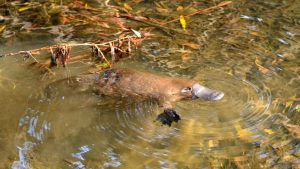14.5 Mammal Sex
Mammals fall into three reproductive categories: monotremes, marsupials, and placental mammals. We will focus on one type of placental mammal (humans) for most of the remainder of this chapter, but the reproduction of monotremes and marsupials is interesting and worthy of mention.
Monotremes are clearly mammals because they have fur and they nurse their young with milk. However, monotremes are distinct from other mammals because they lay eggs. The only extant (or, not extinct) monotremes are platypuses and echidnas. Similar to that of other mammals, monotreme fertilization is internal. However, the genitals of monotremes differ from those of other mammals in that the females have a cloaca for urination, defecation, and copulation. Echidna males have a penis with four heads, two of which are active at a time. The males do not urinate from the penis, instead they have a cloaca similar to that of the female. Platypuses have two-headed penises, however the left penis is more developed. Female platypuses have two ovaries, but only the left one functions. In echidnas the eggs are incubated in a specialized pouch, while platypuses curl up around the eggs to incubate them. And like other mammals, all monotreme babies nurse to obtain nutrients from the mother, but they do so by lapping at specialized pores on the mother that secrete milk.

Marsupials are mammals that include opossum, kangaroos, koalas, wombats, and wallabies. Marsupials have internal fertilization that involves a bifurcated (split) penisin males, and two vaginas and two uteri in females. These animals give birth to very undeveloped young. The newborn animals make their way to a pouch in the mother. In the pouch they nurse for several weeks or months as they develop further, and become less dependent on the mother.
Placental mammals (including humans) have internal gestation, in which the offspring develops further than in marsupials, and nutrient exchange between mother and fetus relies on a well-developed placenta. The placenta is an organ formed during embryonic development. The placenta allows for nutrient and waste exchange between the mother and the developing offspring. While marsupial mammals also have placentas, the structure in the placental mammals is much larger to allow these animals to develop further internally. Like monotremes and marsupials, after birth, infant placental mammals obtain nourishment by nursing.
- By Klaus - Flickr: Wild Platypus 4, CC BY-SA 2.0, https://commons.wikimedia.org/w/index.php?curid=32551315 ↵

